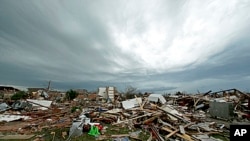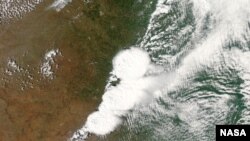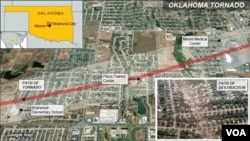U.S. search and rescue crews are digging for survivors in the area where a massive tornado leveled neighborhoods Monday in the central state of Oklahoma, killing at least 24 people and injuring nearly 240 others. The twister is the nation's deadliest since a 2011 tornado in Joplin, Missouri, killed more than 150 people.
Monday's tornado tore through the town of Moore, a suburb of the state capital, Oklahoma City, leaving a path of destruction up to three kilometers wide and 32 kilometers long.
Oklahoma Governor Mary Fallin called it one of the "most horrific" disasters the state has ever faced.
"In many places, homes were absolutely destroyed, taken away. There's just sticks and bricks basically," said Fallin. "It's hard to tell if there was a structure there or not. If you get into some of the major neighborhoods, you can't tell where the streets were. The street signs are gone. And that's been a big challenge for us, [...] being able to determine which area of a community we might be in, because the streets are just gone, the signs are just gone."
The tornado ripped through the area around Oklahoma City with winds of up to 320 kilometers an hour. Among the flattened buildings was an elementary school, where children lost their lives.
U.S. President Barack Obama declared a major disaster in Oklahoma following the storm, ordering the Federal Emergency Management Agency, or FEMA, to provide assistance.
FEMA Administrator Craig Fugate said the agency's job is to support local officials and first responders who have been working since the tornado struck. He said people outside of Oklahoma can help, too, by donating to volunteer organizations such as the Red Cross and The Salvation Army.
"If you're not in the area, the best way to help is to send your help through those organizations. And, that's the lesson we've learned time and time again, that stuff isn't as great as cash when it comes to the longer term needs for a lot of folks that have lost everything," said Fugate.
For now, the focus is on rescue and recovery - sifting through the debris and searching for survivors. The Moore fire department chief, Gary Bird, said crews will go through every damaged piece of property in the town at least three times before the process is finished.
Tragically, this is not the first time Moore has confronted grave losses from a tornado. Another deadly twister hit the town in 1999 - one of more than 70 tornadoes to touch down across Oklahoma and Kansas in just 21 hours. Both states are located in an area of the United States commonly known as "Tornado Alley," where most of the nation's tornadoes occur.
Monday's tornado tore through the town of Moore, a suburb of the state capital, Oklahoma City, leaving a path of destruction up to three kilometers wide and 32 kilometers long.
Oklahoma Governor Mary Fallin called it one of the "most horrific" disasters the state has ever faced.
"In many places, homes were absolutely destroyed, taken away. There's just sticks and bricks basically," said Fallin. "It's hard to tell if there was a structure there or not. If you get into some of the major neighborhoods, you can't tell where the streets were. The street signs are gone. And that's been a big challenge for us, [...] being able to determine which area of a community we might be in, because the streets are just gone, the signs are just gone."
The tornado ripped through the area around Oklahoma City with winds of up to 320 kilometers an hour. Among the flattened buildings was an elementary school, where children lost their lives.
U.S. President Barack Obama declared a major disaster in Oklahoma following the storm, ordering the Federal Emergency Management Agency, or FEMA, to provide assistance.
FEMA Administrator Craig Fugate said the agency's job is to support local officials and first responders who have been working since the tornado struck. He said people outside of Oklahoma can help, too, by donating to volunteer organizations such as the Red Cross and The Salvation Army.
"If you're not in the area, the best way to help is to send your help through those organizations. And, that's the lesson we've learned time and time again, that stuff isn't as great as cash when it comes to the longer term needs for a lot of folks that have lost everything," said Fugate.
For now, the focus is on rescue and recovery - sifting through the debris and searching for survivors. The Moore fire department chief, Gary Bird, said crews will go through every damaged piece of property in the town at least three times before the process is finished.
Tragically, this is not the first time Moore has confronted grave losses from a tornado. Another deadly twister hit the town in 1999 - one of more than 70 tornadoes to touch down across Oklahoma and Kansas in just 21 hours. Both states are located in an area of the United States commonly known as "Tornado Alley," where most of the nation's tornadoes occur.










